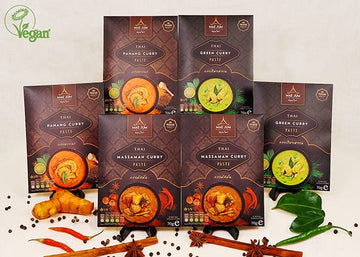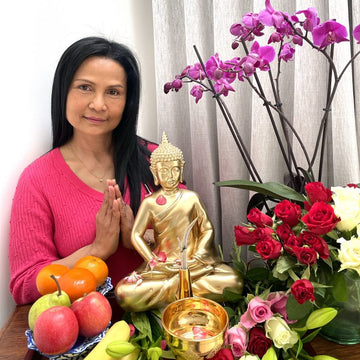Thailand is a country of contrasts—ancient capitals and untouched forests, sacred ruins and pink lotus lakes. For the culturally curious traveller, exploring beyond the usual tourist trail offers something even more rewarding: a deeper sense of connection. In this blog, we journey through three remarkable regions—Ayutthaya, Ban Chiang, and Kaeng Krachan—each offering a unique window into Thailand’s rich heritage, natural beauty, and enduring traditions.
Table of Contents
- Ayutthaya: Echoes of Empire and Everyday Meals
- Ban Chiang: The Red Earth of Prehistory and Isaan Flavours
- Kaeng Krachan: Mist, Biodiversity, and the Taste of the Forest
- Tips & Advice for Meaningful Heritage Travel
- Final Thought
Ayutthaya: Echoes of Empire
Ayutthaya’s story is one of dazzling prosperity, devastating conflict, and enduring legacy. Founded in 1350 by King U Thong, the city was strategically located at the confluence of three rivers—the Chao Phraya, the Lopburi, and the Pa Sak—which connected it to the sea and turned it into a flourishing trade hub. For over four centuries, Ayutthaya reigned as the capital of the Siamese Kingdom, welcoming traders from as far afield as Japan, Portugal, Persia, and France. The architecture of Ayutthaya reflects this cosmopolitan past. Sadly, much of the city was reduced to ashes in 1767 when Burmese forces invaded, looting its treasures and leaving much of it in ruins. Still, the grandeur lingers.
Ayutthaya is about an hour drive from Bangkok and it is really easy to get there. There are a number of options — public transport, tours, self-drive, or you could hire a driver. Hiring a driver is the most convenient option as you can go at your own pace, stop by different eateries or markets, and possibly offer some other recommendations too! There are many historic temples you can visit within the Ayutthaya National Park.
Entry to individual temple sites such as Wat Mahathat, Wat Phra Si Sanphet, and Wat Ratchaburana typically costs around 50 THB per temple. However, if you’re planning to visit several sites, it’s worth buying the combined temple ticket for 220 THB, which covers entry to the 6 main temple ruins. You can purchase the temple pass at the entrance of all the 6 temples the pass gives access to.

Wat Mahathat
Perhaps the most photographed site in Ayutthaya, Wat Mahathat was once the religious centre of the kingdom. Built in the late 14th century, it housed sacred relics of the Buddha. Its most famous feature today is the stone Buddha head serenely enveloped by the roots of a tree.
Wat Ratchaburana
Wat Ratchaburana, the Temple of the Royal Restoration, was constructed in 1424, King Borom Ratchathirat II as a memorial for his two elder brothers, who died in a power struggle for the throne. King Borom Ratchathirat II ascended the throne after the death of his brothers and was the seventh king of Ayutthaya. The main prang (tower) of this temple is considered one of the most well preserved in Ayutthaya and used to house treasures before some were looted in 1957.
Wat Yai Chai Mongkhon
Originally built in 1357 by King U Thong for monks returning from Sri Lanka, it’s best known for its towering chedi, erected to commemorate victory over the Burmese. You can climb the steep steps for sweeping views of the temple grounds, where rows of serene Buddha statues draped in saffron robes line the walls. Unlike many ruins, this temple is still in use, and you’ll often see Thai families paying their respects or releasing birds for good merit. It’s a lovely spot to witness living tradition within ancient walls.

Ban Chiang: The Red Earth of Prehistory and Isaan Flavours
Long before the Kingdom of Siam or the glories of Ayutthaya, there was Ban Chiang—a sleepy village in Udon Thani province that turned out to be one of Southeast Asia’s most significant archaeological sites. In 1966, a chance stumble over a tree root led to the discovery of ancient pottery shards, eventually revealing a buried Bronze Age civilisation that thrived over 5,000 years ago. Today, Ban Chiang Archaeological Site is a UNESCO World Heritage Site and a fascinating journey into Thailand’s deep past.
The highlight is the Ban Chiang National Museum, where beautifully painted pottery, bronze tools, and burial artefacts are displayed with care and clarity. The iconic red spiral pottery designs are instantly recognisable and hint at a society skilled in ceramics, metallurgy, and early farming. Nearby, visitors can also explore a preserved excavation pit showing skeletons and artefacts in situ—providing a powerful sense of connection to those who walked this land.
Red Lotus Lake: A Dreamscape on Water
Just an hour south of Ban Chiang lies one of Thailand’s most enchanting natural wonders—Red Lotus Lake, or Talay Bua Daeng as it’s known locally. From December through February, this vast freshwater lake near Kumphawapi transforms into a painter’s palette of soft pinks and greens. Thousands upon thousands of lotus flowers bloom across the surface, creating the illusion of a floral sea stretching to the horizon. The magic happens early—by mid-morning, the blooms begin to close with the rising heat. To experience it at its most breathtaking, arrive just after sunrise and board a small boat that glides quietly among the blossoms. It’s a peaceful, almost meditative experience, broken only by the occasional call of a heron or the ripple of fish beneath the lilies. Photographers and nature lovers will be in heaven here.

Fun Fact! Despite the name, the flowers here are actually a vivid pink. Local legend links the lake to fertility and renewal, making it a popular spot for couples and spiritual seekers. Travel Tip: Boats can be hired at the lake for around 300–500 THB, depending on the route and length of the trip. Mornings are best—aim to be on the water by 6:30 or 7:00 AM for peak bloom and cooler temperatures.
Where to Stay
TThe city of Udon Thani is a great place to stay when visiting Ban Chiang (45 minute drive) and the Red Lotus Lake (40 minute drive). Udon Thani is well-connected by daily flights and trains from Bangkok, making it an easy hub for exploring northeast Thailand. It’s also just an hour’s drive from the city of Nong Khai and the Thai-Lao Friendship Bridge, ideal if you're planning an onward journey to Vientiane, capital city of Loas.
Make sure to visit UD Town and UD Night Market. Located just steps from the city’s train station, UD Town is Udon Thani’s vibrant lifestyle hub, a buzzing blend of shopping, dining, and entertainment. By day, it’s a laid-back complex of boutiques and cafés, but come evening, the air fills with the aroma of grilled meats, sizzling seafood, and som tam from delicious market stalls. Just beside UD Town is the UD Night Market, where locals gather here for casual dinners, live music, and late-night shopping, browsing everything from handmade crafts to quirky fashion.
Did You Know? Udon Thani was once a key base for the US military during the Vietnam War. This history still echoes in parts of the city, especially in the foreigner-friendly farang quarter, where you'll find a community of long-term travellers who never quite left!
Kaeng Krachan: Mist, Biodiversity, and the Taste of the Forest
Nestled in the Tenasserim Hills near the Myanmar border, this is Thailand’s largest national park—spanning over 2,900 square kilometres of dense rainforest, cascading waterfalls, and hidden caves. Kaeng Krachan is still something of a hidden gem, favoured by birdwatchers, nature lovers, and Thai families looking to escape the crowds. It’s part of the Western Forest Complex and was granted UNESCO World Heritage status in 2021 due to its rich biodiversity, including leopards, wild elephants, dusky langurs, and over 400 bird species.
Pa La-U Waterfall
With 16 tiers cascading over mossy rocks, it’s one of the tallest waterfalls in Thailand and a favourite spot for gentle jungle treks. The first few levels are easily accessible via shaded paths, where you’re likely to spot butterflies in dazzling colours, especially during the cooler months. If you’re feeling more adventurous, try climbing up to the higher tiers where you will be rewarded with peaceful pools perfect for a refreshing dip. There are lots of macaque monkeys and rare birds, so keep your eyes peeled and your camera ready. Whether you're there for a quiet picnic or a forest hike, Pa La-U’s soft roar and green embrace make for a truly tranquil day out.
Phanoen Thung Viewpoint
Waking before dawn may not be everyone’s idea of a holiday treat—but at Phanoen Thung Viewpoint, it’s an experience you won’t soon forget. Located deep within Kaeng Krachan National Park, this elevated lookout sits at around 1,200 metres above sea level and offers a panoramic view over the vast forest canopy below. On cool mornings, especially between November and February, a thick sea of mist rolls across the treetops, creating an almost dreamlike landscape. As the sun rises, golden light pierces the haze, revealing layer upon layer of untouched jungle stretching to the horizon.The viewpoint is also one of the best spots in Thailand to hear the haunting, flute-like calls of white-handed gibbons echoing through the dawn. There’s a small campsite nearby for those who wish to stay overnight—a rustic but rewarding experience, especially under star-filled skies.

Access to Phanoen Thung is via a steep, narrow road from Ban Krang campsite and requires a 4WD vehicle. You can either drive yourself or hire a local driver from the park entrance. Day visitors are limited to morning hours, so arrive early and bring warm layers, it can be surprisingly chilly before the sun breaks through.
Travel Tips
- Getting There: Kaeng Krachan is about a 3-hour drive southwest of Bangkok and just over an hour from Hua Hin. The nearest town is Kaeng Krachan Village, where you’ll find convenience stores and small restaurants.
- Park Entry: The entrance fee is 300 THB for foreigners and 100 THB for Thai citizens. The park is typically open from November to July and closed during the rainy season (August–October) to allow for natural regeneration.
- Transport Inside the Park: A private vehicle is the most practical way to explore, though local guides with 4x4 trucks are available for hire—especially if you're heading up to Phanoen Thung. There’s pretty much only 1 road in the park, so it lowers the risk of getting lost but be warned, the road can be very bumpy!
Tips & Advice for Meaningful Heritage Travel
- Travel with intention: Take time to learn the story behind each site—not just the dates and names, but the rituals and foods that define the place. Ask a local about their favourite dish or family tradition.
- Eat near the roots: Look for small, family-run eateries or market stalls near heritage sites. The best meals are often the simplest, made with local ingredients and a sense of pride.
- Respect the rhythm: Many sites, especially temples, follow a daily rhythm—alms at dawn, midday meals, and quiet hours for reflection. Participate, observe, or simply sit and take in the moment.
- Leave no trace: Thailand’s natural and historic sites are precious. Take only memories, leave only footprints, and always dispose of rubbish thoughtfully, especially when picnicking or eating outdoors.
Final Thought
From the regal ruins of Ayutthaya to the red earth of Ban Chiang and the emerald canopy of Kaeng Krachan, Thailand offers more than just beautiful sights—it invites you to listen, taste, and feel its living history. Each destination is a chapter in a much larger story, one best savoured slowly, with curiosity and care. Whether you're a history buff, a nature enthusiast, or simply someone who loves a good bowl of larb by the roadside, let these places deepen your love for Thai culture.
Ready to keep exploring? Discover more authentic Thai recipes and regional flavours at Mae Jum’s Recipe and bring a little bit of Thailand home with Mae Jum Thai Pastes.







